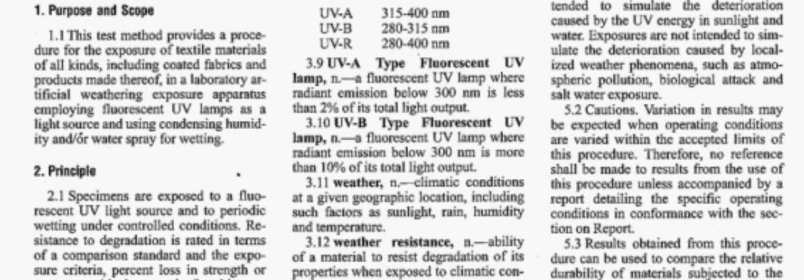UV Light and Moisture Exposure

AATCC TM186-2001 pdf free.Weather Resistance: UV Light and Moisture Exposure.
8.1 The test cycle is best detcrmincd by the influencing factors of the end use, in paticular, thc clirmatic oonditionsNot allmatcrials are affected equally by the same environmcnt.Results obtained by the use of any one test cycle may not berepresentative of thosc of any other test cycles or any ouldoor weatbering test.Any accelerstion factor derived for onegeographic location does not nocessarilyapply to any other gcographic locatiom.However,certain test cycles aresug-gestod to group sinilar climates with respect to the test cycle.
8.2 The natare of the test material contributcs to the selection of the appropriatetest cycle with respect to Uv exposure,wetting. wet time and temperature. Thefollowing test cycles options have beenusod for textile materiails.
8.2.1 Option 1,General Applications:8 hUV at an irradiance of 0.77 w/m@340 nm at 60°C followed by 4 h condensation at 50°C.This option is used forgencral applications such as outdoor fur-niture fabrics, tcnt material, etc.
8.2.2 Option 2,Thcrmal Shock Appli-cations: 8 h Uv at an irradiance of 0.77W/m@340 nm at 60 C;followed by0.25 h water spry; followed by 3.75 hcondensation at 50C.This option hasbeen used for architectural and other ap-plications whcre thcrmal shock may bean issue.
8.2.3 Option 3,Automotive Exterior: 8h UV at an irradiance of 0.72 w/m@340 nm at 70C followed by 4 h conden-sation at 50C.UV irmadiance may bemonitored and maintained by the manualmcthod or by the foed-back-loop methodas describod in SAE J2020.
8.3 The use of these cycles docs notimply, expressly or otherwise, an acceleraled weathcring test,nor is this methodrestricted to the use of these cycles.Thedegree of conrelation to any actaal out-door weathering exposure musr be dcterrmined by quantitative analysis.
9.Standards of comparison
9.1 Standards for comparisons can bemade of any suitable textile materialwhcre a history of strength dcgradation orcolor change rates are known dependingupon individual test needs.They imust bcexposed simultaneously withthe testspecimen to be investigated.The intent ofthese standfards is to demonstrate unifor-mity betwecn separate machine and testruns. When test data of the cxposed stan-dards differ by more than 10%from theknown data,the test machine opcratingconditions must be thoroughly reviewedand any malfunctions or defective partscorrected.Tbe test is then repcated.lif thedata still differ by msore than 10%firomthe known data and thcre is no evidenceof machine malfunction,then the teststandard should be questionod and re-evaluated.Test data obtained with ques-tionable standards must be treated withcaution and rcsolution provided withquantitative analysis.
10.Procedare
10.1 Maintain and calibrate the apparatus in accordance with the manufacturer’s recommendations.
102 Before beginning the exposuretest, bring aill spccimens, control and test,tomoisture equilibritm in the atmo-sphere for testing textiles in accordancewith ASTM D i776,Standard Practicefor Conditioning and TestingTextiles.Equilibrium is considered to have bocnreached when the incrcase in mass of thespecimcn in sucoessive weightings madeat inalervals of not less than 2 h does nolexceed 0.1%of the mass of the specimcn.Perform any necessary tests or evalua-tions neccssary to cstablish a base line forconparing the unexposed specimcns tothe exposed specimens.
10.3 Specimen Mounting. Mount the specimens in the frames which are supplied with the cabinet with the test surfaces facing the lamp. When the test specimens do mot completely fill the racks, the empty spaces must be filled with blank panels to maintain the test conditions within the chamber.
10.3.1To provide rigidity, flexible specimens may be attached to a backing pancl made of aluminum or other DOnCOr rosive heat conductive material.
10.3.2 Holes in specimens and any openings langer than I mm around irregBlarlty shaped specimens shall be sealed to prevent loss of water vapor, Porous specimens shall be backed with a vapor barrier such as aluminum or plastic.AATCC TM186 pdf download.UV Light and Moisture Exposure